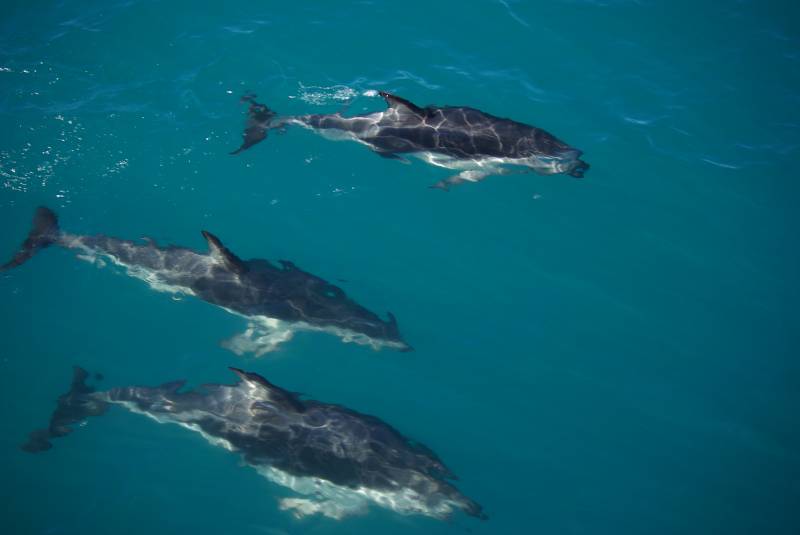
Dusky Dolphins outside Kaikoura.
New Zealand is one of our favourite places to travel, and the one place from the last trip we’re returning to this time. The last time we started on the North Island and worked our way south, feeling like we were running out of time for some of the things we wanted to see on the south end of the South Island – so this time we’ll go the other direction. After first spending a couple days in Auckland trying to convince Teresa to jump from the sky tower (there’s nothing high in New Zealand that someone hasn’t strung a bungee from) we flew down to Christchurch on the east coast of the South Island and picked up a rental car. Rental cars are, by some strange accident of economics, almost for free in New Zealand – we were surprised to get the same per-day price this time as we had on the last trip back in 2005 (that time for six weeks in mid-winter low-season, now for three weeks in spring). At 22 kiwi dollars per day it’s less than 4 euro per person splitting on three… Ended up with an automatic though, which I haven’t driven for a decade…worked it out except for the mysterious L mode (..turns out to be same as 1).

The odd Moeraki boulders south of Oamaru.
From Christchurch we headed up to Kaikoura to go whale watching the next morning. There’s a deep ocean trench called Hikurangi just off the coast by Kaikoura where the sea floor drops to a kilometer deep just the same distance out from the shore, and there’s sperm whales there year-round (and Humpback’s and Orca’s at different times a year). The crew on the boat used an underwater hydrophone to track a sperm whale as it was coming up to surface after a hunt, and we watched it at the surface for 5-10 minutes until it made a tail splash and dove down for more squid. After this we came across a large pond of Dusky dolphins which the boat continued to follow for a while (or was it the other way around?). It was nice to watch them from the boat this time – on the last trip we went out on a swim-with-dolphins tour in the depth of winter – we had booked it as a nice surprise for my brother Mikael who was joining us back then for a couple weeks..he’s as tall as me but 10 kilos lighter, and with no body fat whatsoever he actually sink by default in sea water, even with a full breath, and no full-body wet-suit could keep him warm…they had to put a hot-water hose inside the suit back on the boat to stop him from turning purple… It was pretty freezing, and all in all the dolphins are more peaceful to watch from the boat.
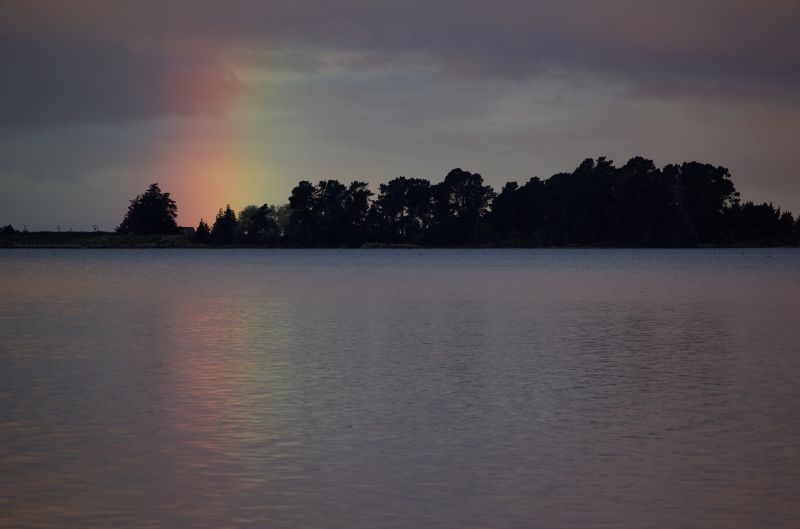
Rainbow at dusk south of Moeraki.
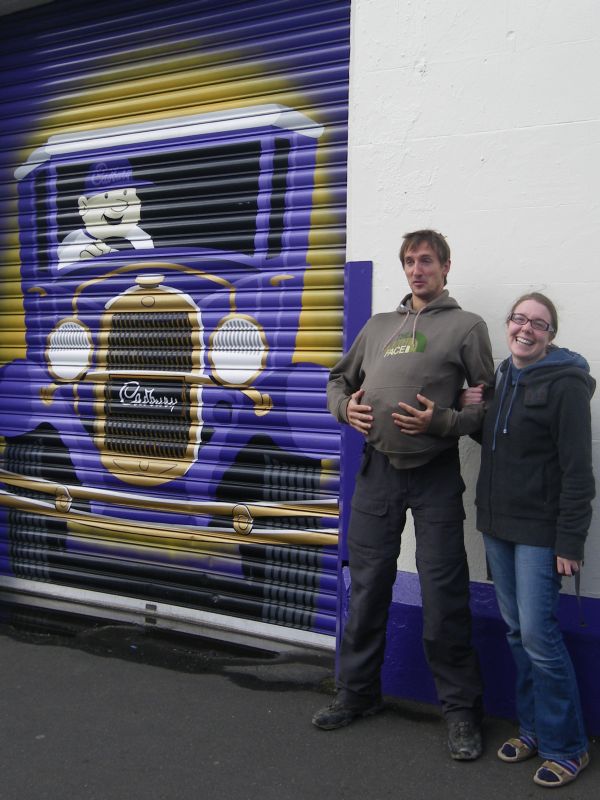
Too...much...chocolate...
From Kaikoura back to Christchurch via Hanmer springs for some nice soaking in the hotsprings, then on to Dunedin the next day – stopping in Oamaru to have a look at the colonies of blue penguins there (the worlds smallest). In Dunedin we did a tour of the Cadbury Chocolate Factory (complete with a “chocolate waterfall”!) and were showered with enough samples to keep us off healthier fruit and granola bars in the car for several days.. Dunedin to Invercargill the next day via the Southern Scenic Route, passing the Catlins coast with nice fern-filled forests and waterfalls. This is the south-east corner of the South Island, where like on much of the west coast you can drive for hours without seeing anyone (we’re still a few months away from high-season luckily).
From Invercargill we continued the Scenic Route until reaching Fiordland, with white-capped mountains starting to appear on the horizon, and spent a night in a countryside hostel by a deer farm. Next day we continued to Milford Sound, the one of the remote Fiordland fjords that is reachable by road, with plenty stunning short walks to do on the way – gorgeous mossy forests around lake Gunn, and a trek up the 950m Key Summit from the Divide pass for some fantastic 360 degree panoramas – we could spot the glacial lake Marian that we trekked to on the last trip in the distance. Many of the curious alpine Kea parrots were hanging around the stops along the way.

View from Barnyard Backpackers.

The Rainbow Reach mountains.
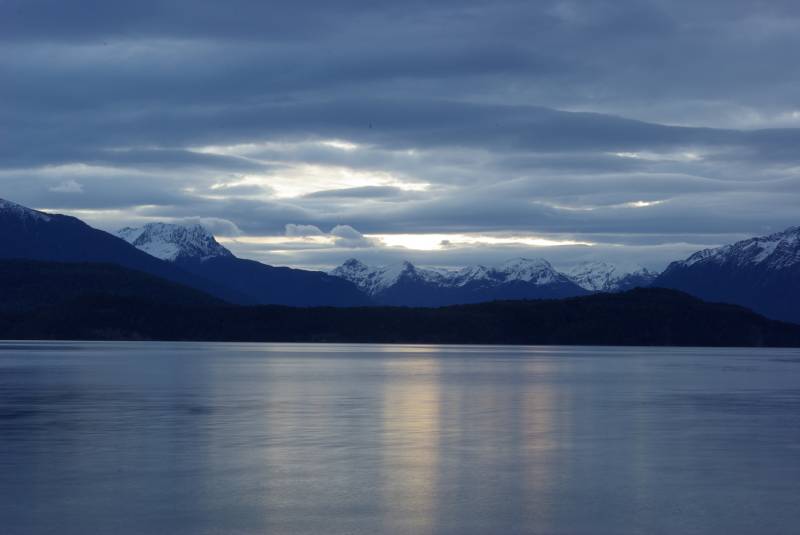
Sunset over Lake Manapouri.
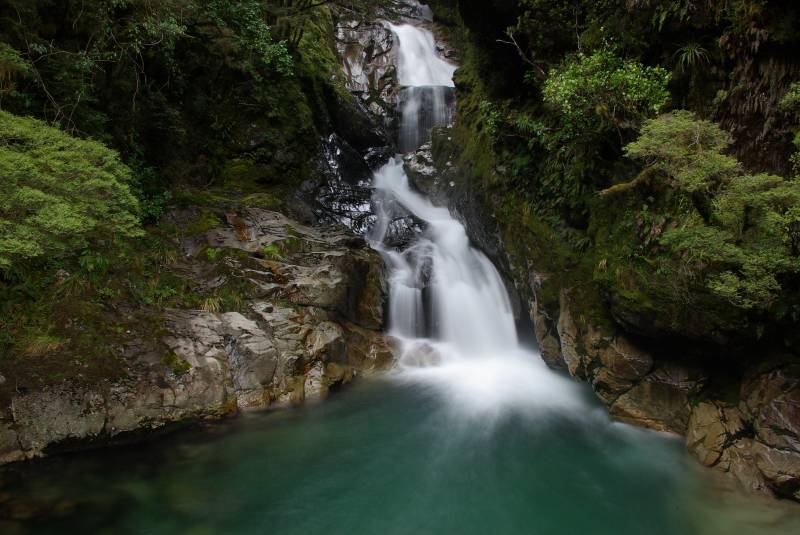
Waterfall along the road to Milford Sound.

Kea alpine parrot in Milford Sound.
In Milford Sound we got ourselves on a cruise of the fiord for the morning; this is where the scenery really topples over to outdo itself…steep high peaks that run straight down into the water – what the Himalayas would look like with a 5000m higher sea-level – and tall waterfalls crashing straight down from the mountains into the fiord, the spray catching rainbows in the early morning sun… Really spectacular. A couple bottle-nose dolphins followed the boat as it set out into the fiord.
Milford Sound is one of the absolute rainiest places in the whole world – 8000mm per year – but it actually held up while we were out…however the captain did manoeuvre the ship right in underneath some of the waterfalls to compensate.
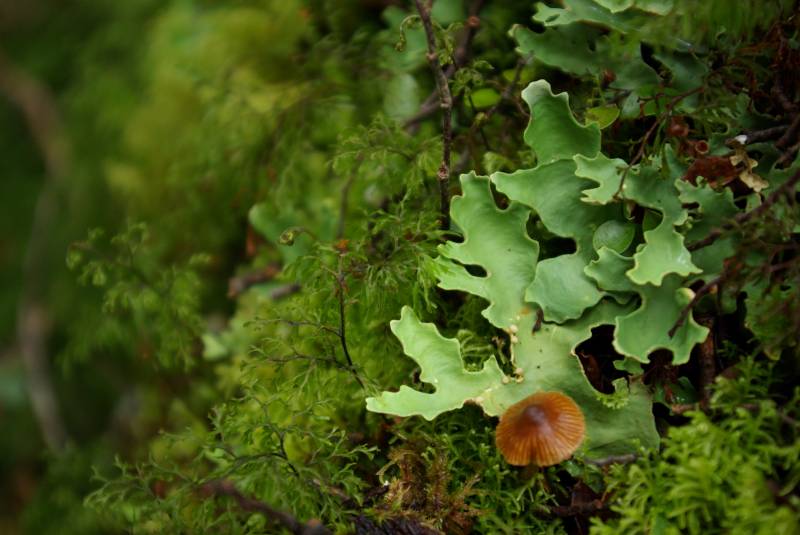
Mossy forest by Lake Gunn.

Mossy forest by Lake Gunn.
More nice stops on the way back from Milford, including the 200m Humboldt falls, then stayed in Te Anau which is the first town when driving back out from the fiord, and did a trip into a glow-worm cave in the morning. Glow-worms are insects that live in the cave ceiling and attract food to their sticky threads with a faint blue light, when the caves are really full of them like this one was it makes a pretty magical place – whole constellations and galaxies above as we moved around slowly in a small boat through the darkness and silence deep inside the cave. Before leaving Te Anau we also popped by a wildlife center, to see Takahe (flightless presumed-extinct-until-1950 bird) and more of the funny Kea and Kaka alpine parrots..spotted a spectacular mating dance in the Kea cage! (movie clip)
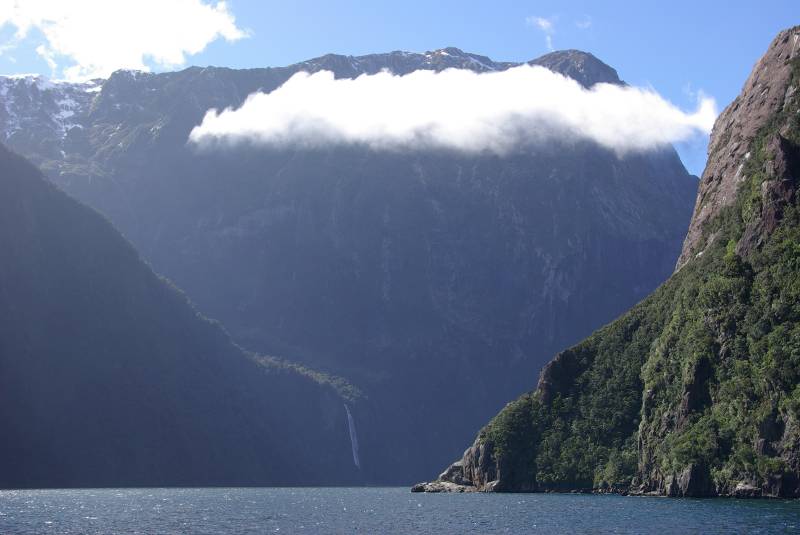
View over Milford Sound.

Waterfall in Milford Sound.
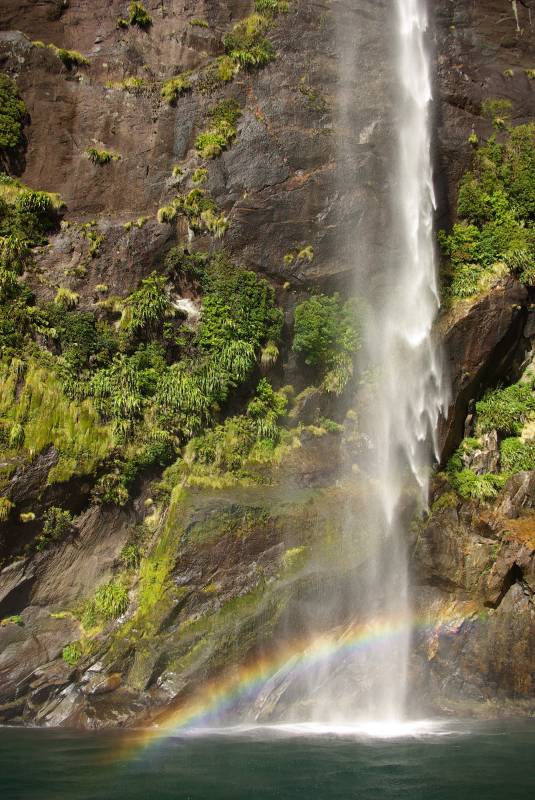
Waterfall in Milford Sound.
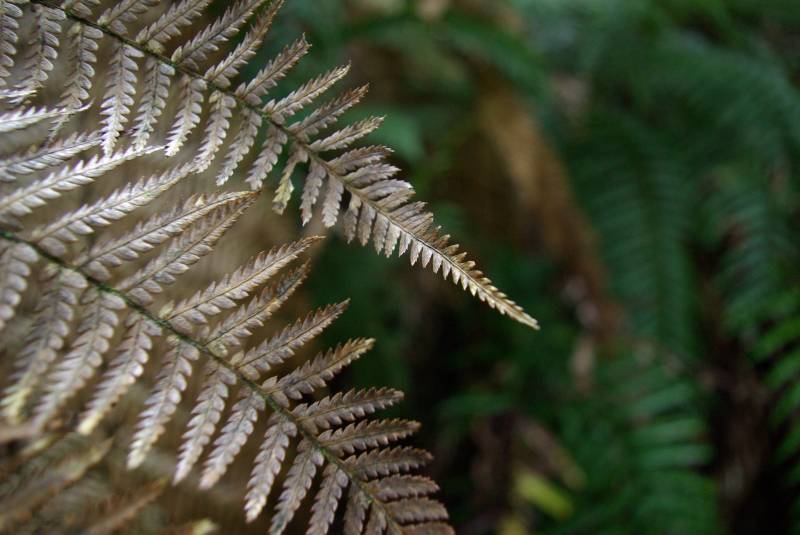
Fern in the forest below Lake Marian.

View between Te Anau and Queenstown.
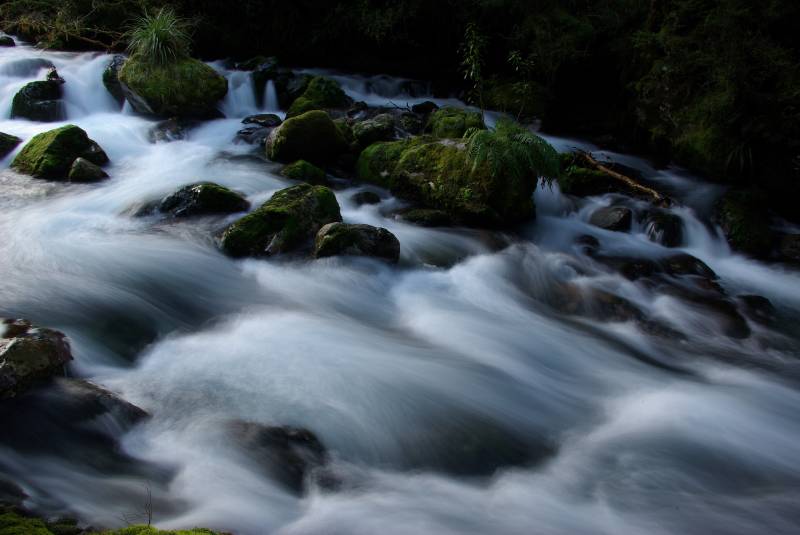
Cascades in the forest below lake Marian.
Drove to Queenstown next – the NZ adrenaline capital – for some relaxing…the first time we spent two nights at the same place and it was nice with a break from driving. Did a jetboat tour on a river though, to do at least one of the adrenaline activities (it’s a special type of boat that can do 360’s and go on water just decimeters deep..going crazy fast right next to the canyon walls is a local speciality). The road there was nearly as adrenaline-inducing though actually…a broken old gold-digger gravel-road leading in to a deep canyon with big drops on the side…almost in a poor enough state at times to give us India flashbacks.
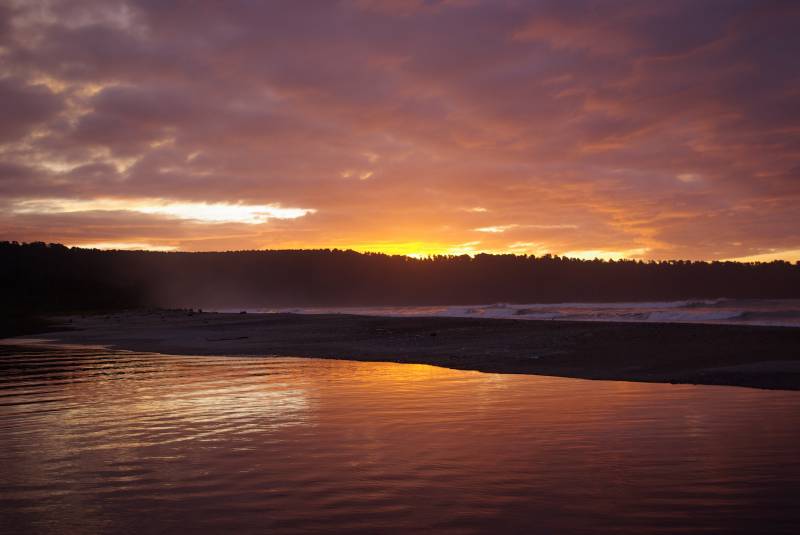
Sunset on the South Island.

Sunset on the South Island.

Sunset on the South Island.
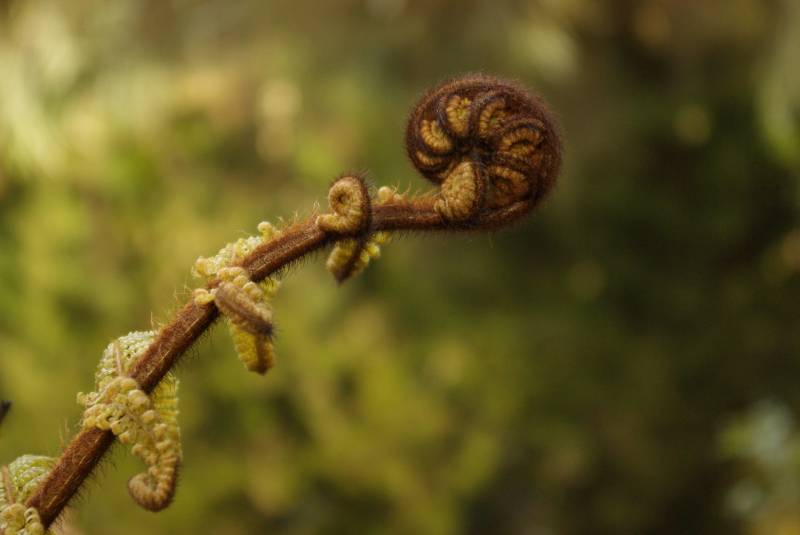
Fern on the Kahikatea Swamp Forest walk.
On towards Fox Glacier next – more stunning scenery and waterfalls along the way out towards the coast, stopping by a long beach full of drift-wood and doing a walk through a swamp forest full of ancient podocarps. Got a motel in Fox for a night and went for a sky-dive in the morning. I’d done one with Mikael on the last trip (he’s a brave man..I’m surprised he was up for getting pushed out of a plane after we had just nearly tried to kill him with the icy dolphin swim the previous week..). Fox is an awesome spot for it, with stunning views over two long glaciers and towards New Zealand’s highest mountain Mt. Cook as you go up in the plane, but I still wasn’t completely sure I wanted to this time…while I’ve done bungee-jump/tandem skydives/hang gliding/paragliding as well as Indian public transport before, I do still have a dislike of heights. My brain was fumbling around for an excuse… “150 euros..imagine how much chocolate you could…” but didn’t come up with a good enough one so up we went me and Teresa, Edel stayed behind to watch the tiny plane take off into the sky with us packed like sardines inside. Once it climbed high enough – about level with the peak of Mt. Cook at 12,000 feet – the plane slowed down and the engine quietened…goggles and gloves on…heart-rate up! The door swung open and Teresa + tandem-buddy swung their legs out and dropped first, disappearing suddenly without a sound – then me and my co-faller Deano moved into position – concentrating on forcing a smile for the camera on the wing…did it take the photo yet?…and aaaaaaaaaaaaaaaaaaaaaaaah! Accelerating like a falling rock for a few seconds until the wind resistance match the gravity at around 200 km/h. Great buzz, and it amazed me how much control the jumpers can have even during the freefall – Deano made sure we rotated around slowly for a full 360 view before opening the parachute. Spotted the other pair in the air a little later, and both did a smooth landing..felt like jumping up and down afterwards with the adrenalin buzzing…and Edel had to put up with us harping on about how great it was for the next 24 hours.

Edel and Teresa by Cape Foulwind.
We drove up to Fox glacier next (passing the “glacier was here in 1850” sign a few kilometers back…yes, we’re in trouble) and did a short walk, then headed on to Greymouth with another nice west-coast sunset on the drive north. Another long day of driving the next day – stopping by the odd pancake rocks by the coast on the way, and the Cape Foulwind seal colony (like Poverty Bay, Doubtful Harbour and Cape Kidnappers named on some of Captain Cook’s less fortunate days…). Took the ferry from Picton to Wellington on the north island the next day, and drove up to Turangi. Had planned to walk the Tongariro crossing trek the next day, but the weather was a bit unpredictable – heavy rain the whole day before with park access closed, and actually heavy enough snow just a day after we passed through that cars got stuck through the night on the road! It actually held up the day that we had in between though, but we settled for some shorter walks just in case. The Tongariro national park is quite barren, with a little bit Connemara-type landscapes.

Tongariro national park on the North Island.
Continued on to Rotorua for out last stop before Auckland. It’s one of those rare places that you can actually smell long before you see it…covered in sulphur smoke seeping out through the ground all over it’s a hotspring and geothermal adventure land. We stayed three nights in a motel in town, and it rained nearly non-stop. Went to a polynesian spa one evening, nice with the cool drops of rain on your face while you’re soaking in the hotsprings, and went zorbing another day for another activity where it doesn’t matter if you get wet. Zorbing is a typical New Zealand invention where you hop inside a big transparent plastic sphere suspended inside an even bigger transparent plastic sphere, then roll down a long hill. Comes with a bucket of hot water thrown in for good measure, and you usually laugh the whole way down as you tumble around inside like socks in a washing machine. Felt like a nice way to round up the New Zealand leg of the trip.
More New Zealand photos.
